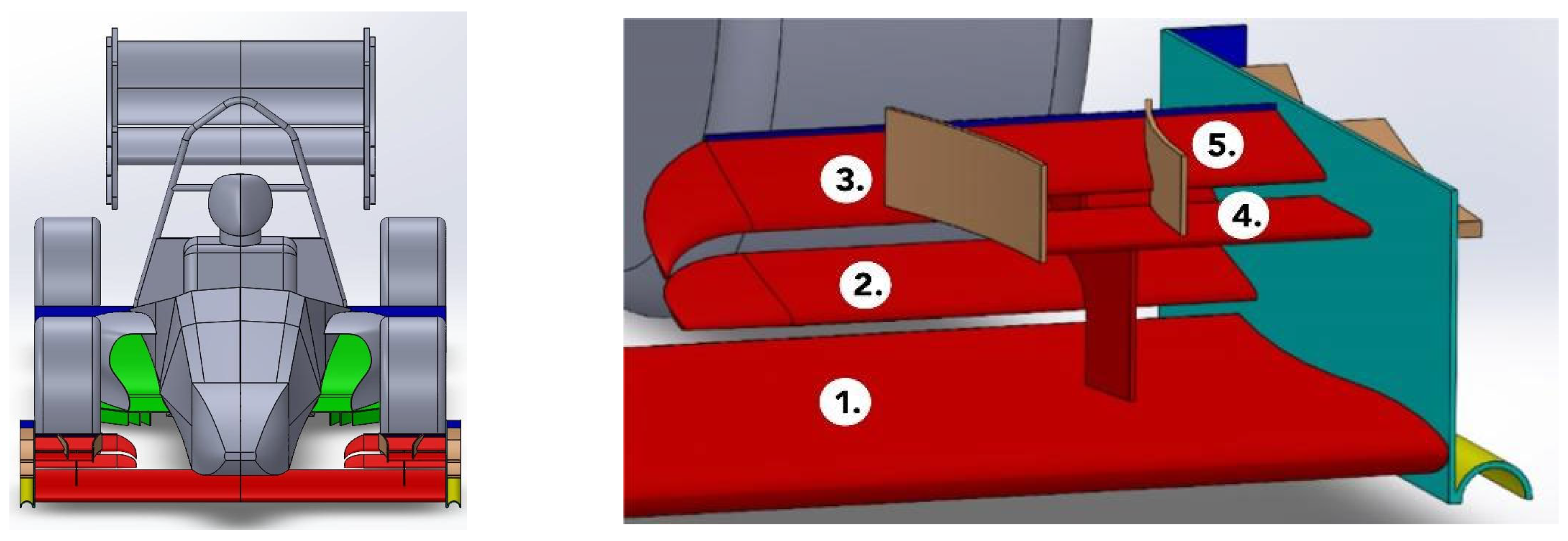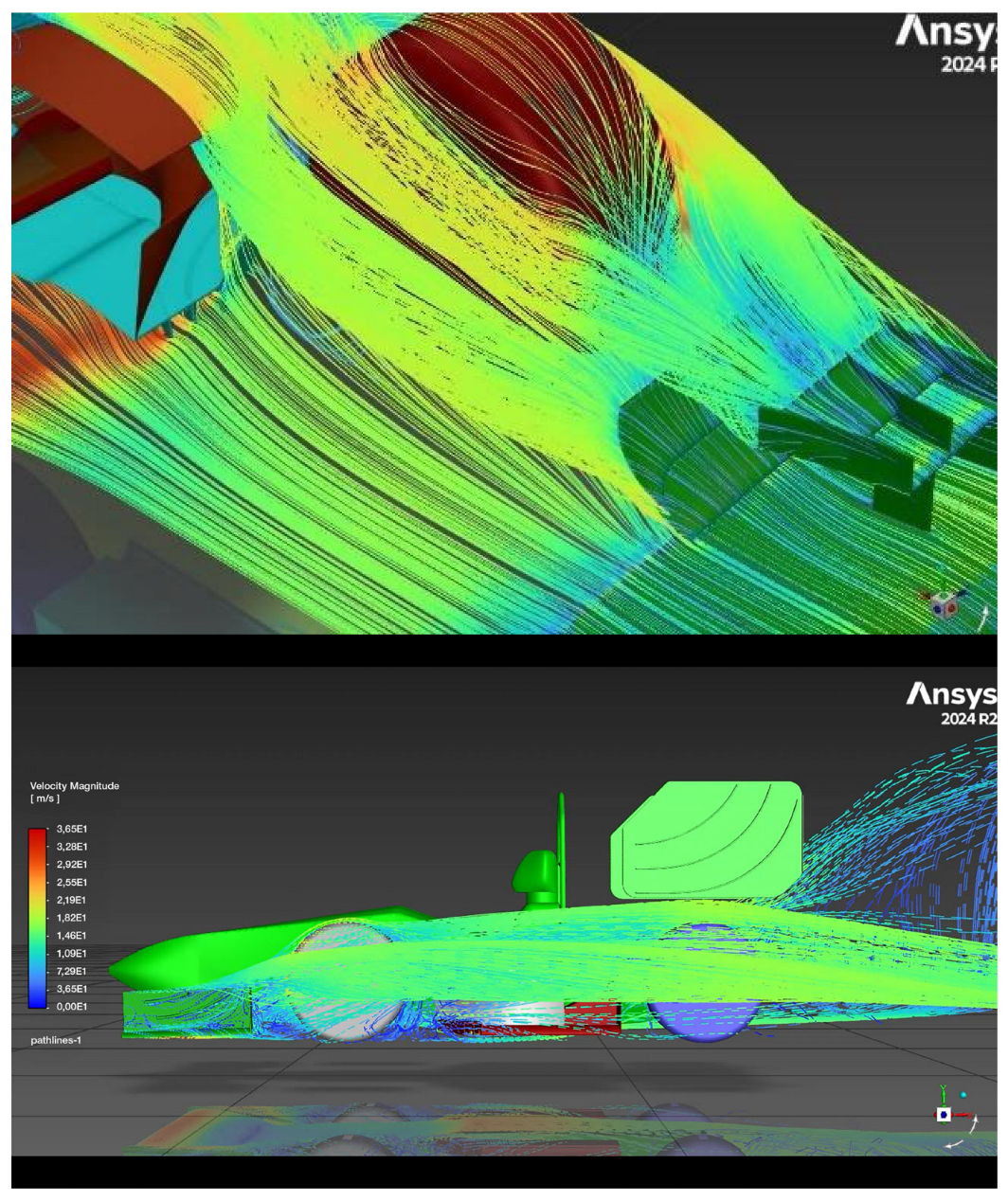1. Introduction
The aerodynamic development of racing cars has played an important role in motorsports since the 1960s. Initially, especially in Formula 1, theories were taken from aeronautics, and they started to use different profiles on cars [
1,
2]. The primary aim of such developments is to reach higher curve speed and the best possible balance for different racetrack characteristics.
These characteristics can also be enhanced by the mass distribution and the wing design of the racing car [
1]. Regarding the mass distribution, it is important to note that for internal combustion and electric designs, different aerodynamic elements are recommended due to the different mass distribution [
1].
Regarding the wing design, the key element of the aerodynamic balance of a racing car is the front wing, whose primary function is to generate downforce, increasing the normal force on the wheels and increasing the grip of the front wheels [
1,
3,
4].
In connection with this, the coefficient of friction of the tires (μ) also determines the lateral acceleration of the car [
1,
2,
4]. By increasing the normal force acting on the wheels, the potential lateral acceleration is enhanced, allowing significantly higher cornering speed and improved braking performance.
Moreover, the front wing significantly affects the floor pan of the car (venturi tunnel), the rear wing, the diffuser, and the efficiency of the engine cooling system. With proper design, the front wing can significantly reduce overall aerodynamic drag while maximizing downforce, contributing to optimal vehicle performance.
An often overlooked yet crucial aspect in front wing design is the significant turbulence generated by the front wheels themselves. This turbulent airflow can substantially reduce the aerodynamic efficiency of the front wing. For this reason, it is important that the front wing have additional elements that generate various vortex flows, so they help direct airflow either inboard (“in-wash”) or outboard (“out-wash”) relative to the front tires, effectively reducing the drag effect.
Finally, yet importantly, when designing the front wing, changing the angle of the wing profile has a major impact on the balance of the car. If the camber angle is increased, so are the downforce and the drag as well. It is essential to note that adjusting downforce levels also shifts the car’s center of pressure (CoP) relative to its center of mass (CoM). When the CoP moves ahead of the CoM, due to a steeper wing angle, the car tends to become oversteered, which means the rear loses grip more easily, and less steering input is needed at higher lateral accelerations to maintain the cornering line. Conversely, if the CoP shifts behind the CoM, the vehicle becomes understeered, requiring more steering input to stay on the intended path as lateral acceleration increases. These balance characteristics are highly dependent on the layout of the racetrack and the driving style of the driver, making fine-tuning the front wing angle a key aspect of setup strategy.
The purpose of this article is twofold. Firstly, a front wing package should be created, which can achieve a significant (at least 15%) increase in downforce for our Formula Student race car.
Secondly, the current CoP position, which lies at approximately 88% relative to the front axle, is intended to be reduced by at least 20%. This adjustment is designed to retain a degree of understeer, ensuring the car remains stable and predictable. While the vehicle will still exhibit understeering characteristics, this change enhances the confidence of the driver and consistency, particularly during high-speed cornering and transitional maneuvers.
2. Materials and Methods
2.1. Design Conditions
The front wing is to be designed for a tube-frame racing car; therefore, it must meet the following conditions:
The Fl/Fd ratio in the design should be at least 3.5;
The minimum downforce at 54 km/h must be at least 125 N (this is the maximum speed of this type of Formula Student race car);
The construction should be easy to manufacture, and it should be as lightweight as possible;
It should have elements that reduce turbulence due to the size of the wheel and help the efficiency of the venturi tunnel in the middle of the car;
The CoP should be closer to the rear axle.
2.2. Selection of Wing Profile
During the front wing design process, three potential configurations were initially considered. Two of these designs featured dual main profiles, with multiple elements shaped along curved guidelines, and included several additional flow control components (
Figure 1).
However, despite their aerodynamic potential, these complex designs were ultimately ruled out due to the significantly higher design time, increased manufacturing complexity, and greater production costs.
The marginal performance gains did not justify the additional effort and resources required for their implementation at this stage of development.
For the aerodynamic base concept, the third design option was selected, which consisted of a three-element wing configuration, complemented by additional flow deflector profiles (see
Figure 1).
To simplify manufacturing, the selected airfoil profile is designed to serve dual functions—it can be used either as a main element or as a secondary element. The main profile refers to the component positioned closest to the tail of the wing, typically featuring the largest chord length, and plays a primary role in determining the aerodynamic behavior of the wing system assembly.
For the profile selection the Airfoil Tools database was used [
5,
6], where a profile with a high
Cl/
Cd ratio (>3.5) (
Cl—lift coefficient,
Cd—drag coefficient) was chosen. This profile is optimized for ground effect and performs well in the low Reynolds number range. To select, the Reynolds number had to be determined with regard to the average speed of the car (50 km/h) and the temperature of the air (20 °C) and asphalt (30 °C) during the spring season:
Taking into account the above yielded value, the FX60-100 10.0% smoothed profile was chosen as the main profile. The height of the profile can be 40–60 mm from the ground [
7], so the chord length was chosen to be 400 mm to ensure that our
h/
c ratio (height/chord) is between 0.1 and 0.3 [
1] and to maximize the ground effect [
8]. This profile works well in environments with a Reynolds number of 10
5–10
6.
NACA 4412 was chosen as an additional profile, as it handles flow separation well and can be used at higher angles of attack, and its shape makes it easier to manufacture. The chord length of all NACA 4412 elements is the same [
2,
6,
7,
9].
2.3. Design of Aerodynamic End Plate and the Gurney Flap
The function of a is to prevent high pressure-air from forming at the top of the profiles from passing underneath the next profiles, where a low-pressure zone is formed. These end plates separate these two zones so that the wing operates more efficiently.
End plates were designed at the edges of wings in order to decrease the arising wing-tip eddies (see
Figure 2). It must be mentioned that the downforce also depends on the geometry of these plates, namely on the so-called wing aspect ratio (shortly
AR). This parameter is defined as the ratio of the wing length to the wing width. By increasing
AR, the theoretical maximum
Cl can be increased as well.
Additional flow control elements have been designed to increase the efficiency of the designed end plate. At the bottom of the end plate is a vortex-generating half-pipe (
Figure 3, highlighted in yellow), which is used to control the flow in front of the wheel and to isolate the venturi tunnel behind. At the end of the half-tube, a Gurney flap [
1,
3,
10] directs the outward flow of air from under the wing. The turbulence from the flaps is reduced by two additional baffles [
1,
2,
4] on the end plate.
2.4. Design of Baffles and Their Profiles
In
Figure 1, the design of wing elements 2 and 3 has been designed to maximize the airflow upward from under the main airfoil (
Figure 1).
The gaps and overlaps between the elements were designed to help delay flow separation. Ensuring the correct angle of upward flow is important to reduce wheel drag, so they are generally spaced between 3% and 5% of the chord length. Their exact size will be determined based on simulation results in the next subsection [
1].
Additional auxiliary wings were also designed for these wing elements to reduce the formation of eddy currents at the end of the wing element and to avoid the need for an end plate to close the airfoil, further reducing the drag of the entire front wing.
In
Figure 1, wing elements 4 and 5 were integrated into the plate to divert as much air as possible above the wheel. Furthermore, these elements also serve as supports for two additional deflection elements. One baffle helps to direct the airflow outwards, while the other directs the airflow inwards, further increasing cooling performance.
In
Figure 1, a Gurney flap is also included on each of airfoils 3 and 5 (
Figure 1) to achieve a larger pitch angle and aerodynamic efficiency [
1,
2]. The height of the Gurney flap provides a greater downforce up to 2% of the chord length.
2.5. Computational Fluid Dynamics Simulation
To investigate the efficiency of the wing, flow simulations were performed to determine the downforce (Fl) and drag force (Fd).
In the simulations, a flow velocity of 15 m/s was defined around the car (the average speed of the car on the racetrack), while a constant speed (15 m/s) was applied on the ground, while wheel rotation was not taken into account.
The k-ε model was chosen as the turbulence model. Octagonal elements were applied to create an unstructured mesh, with 8.2 million elements (local element size 0.1–8 mm). A mesh independence test was carried out, where 7.7 million, 8.2 million, and 9.4 million elements were investigated, respectively. Since only a 0.078% difference was found between the last two mesh configurations, 8.2 million was applied further on.
4. Conclusions
In summary, a newly developed front wing model has been introduced, with additional aerodynamic elements, which can effectively increase the downforce with regard to a race car. In numbers, a total of 32% growth has been reached in lift force if it is compared to the racecar without a front wing and its aerodynamic elements.
In addition, another goal has been achieved, namely the disposition of the CoP, since by applying the proposed aerodynamic set, the CoP moved closer to the front wheel by approximately 30% (reduced from 87% to 58%). The disposition of the CoP provides more control and stability for the pilot, while the car remains slightly understeered.












